Exotics
1/52
There's no tags or description
Looks like no tags are added yet.
Name | Mastery | Learn | Test | Matching | Spaced |
|---|
No study sessions yet.
53 Terms
What is ectothermic?
Where the body temperature depends on external sources such as sunlight or a heated rock surface
Do reptiles usually have a lower or higher RBC size, RBC numbers, and hemoglobin concentration?
Lower
What 2 species have a higher oxygenation capacity
Mammals and avians
What is the normal plasma color in almost all species?
Clear to light yellow
What is the plasma color in herbivores?
Orange to yellow
What is the plasma color in snakes?
Greenish to yellow
What is the plasma color in some lizards and what is it called?
Green - biliverdin
What is the normal PCV in most avian species?
35-55%
What is the normal PCV in most reptiles?
15-55%
Where do RBCs complete maturation in amphibians?
Peripheral blood
When in doubt on if to use EDTA (purple top tubes) anticoagulants, what should you use?
Herapin (green top tubes)
What are 2 ways to perform avian and reptiles RBC and WBC counts?
Hemocytometer and Phloxine B
What are the characteristics of Mammalia RBCs?
Biconcave shape and no nucleus
What are the characteristics of avian, reptile, amphibian, and fish RBCs?
Elliptical, homogenous eos cytoplasm, irregularly round to oval nuclei, and dense chromatin pattern
What is the order of species from the largest RBCs to the smallest?
Amphibians & Mammals → Reptiles → Avian → Feline
What specific species have the largest RBCs?
Salamanders
What specific species have the smallest RBCs?
Sheeps, Goats, and Deer
What type of relationship is between RBC count and RBC size?
Inverse
Give an example of an inverse relationship between RBC count and RBC size.
The larger the RBC, the lower the RBC count
What is the lifespan of avian RBCs?
28-75 days
What is the lifespan of RBCs in felines?
About 70 days
What is the lifespan of RBCs in canines?
About 110 days
What is the lifespan of RBCs in reptiles?
600-800 days
What species has sickle shaped RBCs?
Deer
In what species is hematopoietic tissue not as prominent in bones?
Avian species, think “Birds have hollow bones”
In what species is the bone marrow fibrous, and extramedullary production is more common and productive?
Reptiles
What stimulates erythropoiesis in reptiles?
Sun light
What do heterophils have similar functions with?
Neutrophils
What 4 mammals can have heterophils?
Rabbit, guinea pig, manatee, elephant
What is the characteristic of a heterophils nucleus?
Often bilobed to round, eccentrically located
What are the characteristics of a heterophils cytoplasm?
Colorless, filled with oval to fusiform to rod-shaped orange to brick-red granules
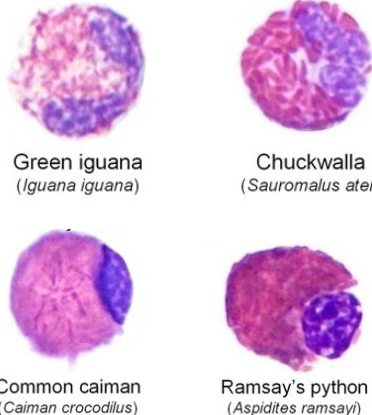
What WBC is this?
Heterophil
What 5 things can be seen in a toxic heterophil?
Increased cytoplasmic basophilia, degranulation, vacuolation, abnormal cytoplasmic granulation, and excessive nuclear lobation
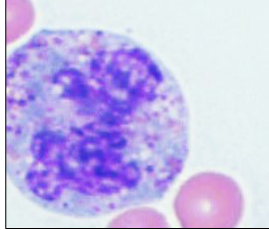
What is this WBC?
Toxic heterophil
What are the characteristics of an eosinophil?
Round to bilobed nucleus, cytoplasm contains numerous round to oval bright pink granules
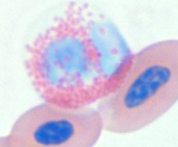
What WBC is this?
Eosinophil
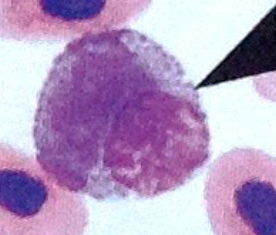
What WBC is this?
Green eosinophil
What are the characteristics of a basophil?
Nucleus is round to oval, cytoplasm contains numerous round purple granules
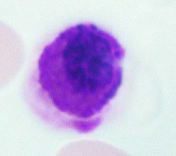
What WBC is this?
Basophil
What are the characteristics of a lymphocyte?
Nucleus is round with dark staining chromatin, cytoplasm is a small amount of pale blue
Lymphocytes are hard to differentiate from what?
Thrombocytes

What is this WBC?
Lymphocyte
What are the characteristics of a monocyte?
Nucleus is oval to bilobed, cytoplasm is blue-gray, may be vacuolated
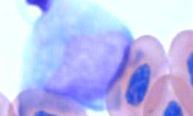
What WBC is this?
Monocyte
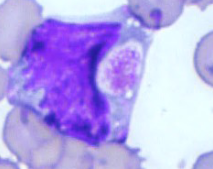
What is this cell?
Kurloff cell
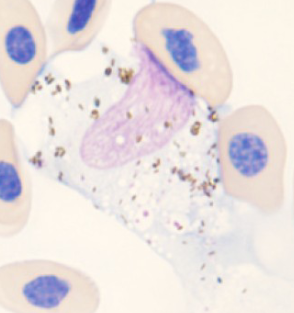
What is this?
Melanophage
What WBC is only in reptiles and have a similar function to monocytes?
Azurophil
What are the characteristics of an azurophil?
Nucleus is round, cytoplasm is light blue to colorless with fine pink-red granules
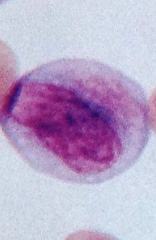
What WBC is this?
Azurophil

When talking about hemoparasites, what is the black arrow pointing to?
Anaplasma
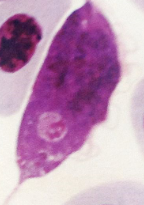
When talking about hemoparasites, what is this?
Trypanosome
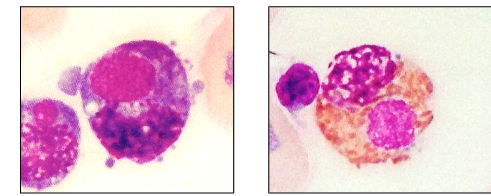
When talking about hemoparasites, what are these?
Iridoviridae

When talking about hemoparasites, what is this?
Filiarid Nematodes